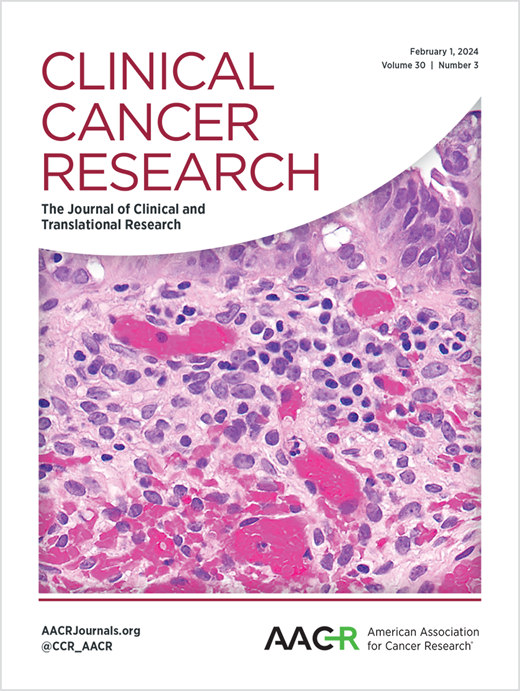TIE2 激酶抑制剂瑞巴替尼与紫杉醇或艾瑞布林治疗 HER2 阴性转移性乳腺癌的 Ib 期临床和药效学研究
IF 10
1区 医学
Q1 ONCOLOGY
引用次数: 0
摘要
目的:乳腺癌细胞通过肿瘤转移微环境(TMEM)通道向远处扩散。在 PyMT 乳腺癌小鼠模型中,TIE2 抑制剂瑞巴替尼可阻断 TMEM 门道功能。我们旨在评估瑞巴替尼联合紫杉醇或艾瑞布林治疗HER2阴性转移性乳腺癌(MBC)患者的安全性和药效学。患者和方法:这项Ib期试验共招募了27名MBC患者,他们接受了50毫克或100毫克瑞巴替尼静脉滴注,每周与紫杉醇80毫克/平方米(如果既往接受过≤2种非他坦类药物治疗)或埃里布林1.4毫克/平方米(如果既往接受过≥1种药物治疗)在第1& 8天联合用药。对安全性、耐受性以及表明TIE2激酶抑制和TMEM门路功能的药效学参数进行了评估。结果首批12名患者在第1或第2周期接受瑞巴替尼治疗时均未出现剂量限制性毒性反应。最常见的治疗突发不良事件(AEs)为贫血(85%)、疲劳(78%)、厌食(67%)、白细胞减少(67%)、丙氨酸氨基转移酶升高(59%)、高血糖(56%)、恶心(52%)和中性粒细胞减少(52%)。瑞巴替尼引起的不良反应包括肌无力和肌痛。100毫克瑞巴替尼剂量水平的眼压升高,而两个剂量水平的血管生成素-2水平均升高,为TIE2阻断提供了药效学证据。联合治疗后,循环肿瘤细胞明显减少。5/23(22%)名可评估患者出现了客观反应。结论对于MBC患者,有药效学证据表明TIE2抑制作用的瑞巴替尼2期推荐剂量为50或100毫克,PO BID,与紫杉醇或艾瑞布林联合用药。本文章由计算机程序翻译,如有差异,请以英文原文为准。
Phase Ib clinical and pharmacodynamic study of the TIE2 kinase inhibitor rebastinib with paclitaxel or eribulin in HER2-negative metastatic breast cancer
Purpose: Breast cancer cells disseminate to distant sites via Tumor Microenvironment of Metastasis (TMEM) doorways. The TIE2 inhibitor rebastinib blocks TMEM doorway function in the PyMT mouse model of breast cancer. We aimed to assess the safety and pharmacodynamics of rebastinib plus paclitaxel or eribulin in patients with HER2-negative metastatic breast cancer (MBC). Patients and Methods: This phase Ib trial enrolled 27 patients with MBC who received 50 mg or 100 mg of rebastinib PO BID in combination with weekly paclitaxel 80 mg/m2 (if ≤ 2 prior non-taxane regimens) or eribulin 1.4 mg/m2 on days 1 & 8 (if ≥ 1 prior regimen). Safety, tolerability and pharmacodynamic parameters indicating TIE2 kinase inhibition and TMEM doorway function were evaluated. Results: No dose-limiting toxicities in cycle 1 or 2 were observed among the first 12 patients at either rebastinib dose level. The most common treatment-emergent adverse events (AEs) were anemia (85%), fatigue (78%), anorexia (67%), leukopenia (67%), increased alanine aminotransferase (59%), hyperglycemia (56%), nausea (52%), and neutropenia (52%). AEs attributed to rebastinib include muscular weakness and myalgias. Intraocular pressure increased at the 100 mg rebastinib dose level, whereas angiopoietin-2 levels increased at both dose levels, providing pharmacodynamic evidence for TIE2 blockade. Circulating tumor cells decreased significantly with the combined treatment. Objective response occurred in 5/23 (22%) evaluable patients. Conclusions: In patients with MBC, the recommended phase 2 dose of rebastinib associated with pharmacodynamic evidence of TIE2 inhibition is either 50 or 100 mg PO BID in combination with paclitaxel or eribulin.
求助全文
通过发布文献求助,成功后即可免费获取论文全文。
去求助
来源期刊

Clinical Cancer Research
医学-肿瘤学
CiteScore
20.10
自引率
1.70%
发文量
1207
审稿时长
2.1 months
期刊介绍:
Clinical Cancer Research is a journal focusing on groundbreaking research in cancer, specifically in the areas where the laboratory and the clinic intersect. Our primary interest lies in clinical trials that investigate novel treatments, accompanied by research on pharmacology, molecular alterations, and biomarkers that can predict response or resistance to these treatments. Furthermore, we prioritize laboratory and animal studies that explore new drugs and targeted agents with the potential to advance to clinical trials. We also encourage research on targetable mechanisms of cancer development, progression, and metastasis.
 求助内容:
求助内容: 应助结果提醒方式:
应助结果提醒方式:


